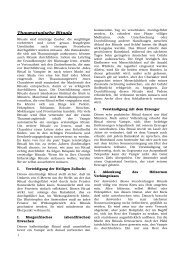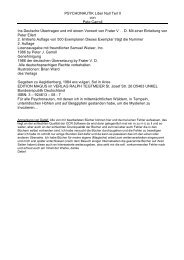CHAPTER 2 CHAPTER 3 CHAPTER 1 CHAPTER 2 CHAPTER 3 ...
CHAPTER 2 CHAPTER 3 CHAPTER 1 CHAPTER 2 CHAPTER 3 ...
CHAPTER 2 CHAPTER 3 CHAPTER 1 CHAPTER 2 CHAPTER 3 ...
Create successful ePaper yourself
Turn your PDF publications into a flip-book with our unique Google optimized e-Paper software.
<strong>CHAPTER</strong> 2 18<br />
Man, intermediate between the Microcosm and the Macrocosm, shows similarity to the atomic structure in the<br />
expansion and contraction of his muscles, in his rhythmic breathing to sustain life, and his shell-like fields of<br />
vibration surrounding the visible body.<br />
Dr. Cecil Bowiby of Los Angeles, California, recently reported that he has succeeded in photographing four<br />
distinct fields of vibration around the human body which are in various colors invisible to the naked eye. They<br />
are, respectively, about one-half inch; six inches; three feet; and nine feet and over from the skin. He believes<br />
the fourth field is the strongest, that is, most extensive when persons radiate strong feelings, especially those<br />
of love and peace.<br />
Now let us consider our own Solar System:<br />
In _One Two Three . . . Infinity_, Dr. George Gamow says: "The picture of an atom began to look more like a<br />
miniature solar system with an atomic nucleus for the sun, and electrons for planets. The analogy with the<br />
planetary system can be further strengthened by these facts: the atomic nucleus contains 99.97 per cent of the<br />
total atomic mass as compared with 99.87 per cent of the solar system concentrated in the sun, and the<br />
distances between the planetary electrons exceed their diameters by about the same factor (several thousand<br />
times) which we find when comparing interplanetary distances with the diameters of the planets. The more<br />
important analogy lies, however, in the fact that the electric attraction-forces between the atomic nucleus and<br />
the electrons obey the same mathematical law of inverse square (that is, the forces are inversely proportionate<br />
to the square of the distance between two bodies) as the gravity forces acting between the sun and the planets.<br />
This makes the electrons describe the circular and elliptic trajectories around the nucleus, similar to those<br />
along which the planets and comets move in the solar system."<br />
However, physicists have stressed the fact that "an atom differs from the solar system by the fact that it is not<br />
gravitation that makes electrons go round the nucleus, but electricity." (H. N. Russell). But what difference<br />
does it make, since gravity and electricity are both manifestations of electromagnetism! This is an example of<br />
scientists calling effect, cause . . . if they looked beyond gravitational and electrical phenomena they would<br />
find the cause of both, which is electro-magnetism.<br />
Another difference was also discovered. An electron in an atom, on absorbing the energy of a photon (light),<br />
jumps to another orbit, and again to another when it emits light and releases the energy of a photon. Because<br />
of this phenomenon, comparison with the solar system did not seem valid. A critic said: "We do not read in<br />
the morning newspapers that Mars leaped to the orbit of Saturn, or Saturn to the orbit of Mars." This is true,<br />
we do not read it in the newspapers, but the atom with its system of electrons rotating around the central<br />
nucleus resembles the planetary system. In considering the atom, the jumping of electrons from one orbit to<br />
another, when hit by the energy of a photon, takes place many times a second, whereas in accord with the<br />
vastness of the solar system, a similar phenomenon occurs there once in thousands of years. Our own Solar<br />
System has experienced displacements in its planetary members over the centuries and this is similar to the<br />
"orbit jumping" of an electron.<br />
The circular motion of an electron around the nucleus of an atom, or a planet around the sun of a solar system,<br />
gives rise to an intensive electro-magnetic radiation, and in this action they are identical. The circular motion<br />
referred to is an effect of intersecting lines of force.<br />
Now let us consider the Galactic System:<br />
Toward the center of the Galactic System is found the nuclear region which corresponds to the sun of a solar<br />
system and the nucleus of an atom. The many solar systems revolving about the nucleus region of a galaxy<br />
correspond to planets revolving about a sun and electrons revolving about an atomic nucleus.<br />
At present astronomers are wondering whether magnetic fields exist in the galaxy. Cosmic radiation suggests






